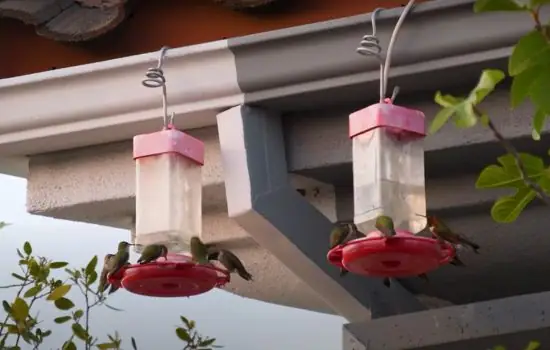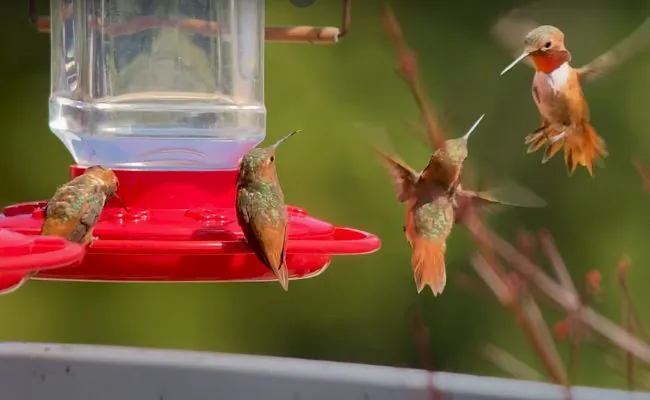Hummingbirds bring bursts of joy when they come for nectar from the feeder in the yard but they get violent and can’t share the nectar. It’s a common sight in the summer – hummingbirds buzzing wildly around a feeder, diving at each other aggressively and not sharing.
Their frequent mid-air battles over access to nectar can become annoying and concerning for us humans hoping to help these tiny birds. We put feeders out to help hummingbirds supplement their diet, not fight to the death!
I love sitting in my backyard watching hummingbirds come to my feeders. It’s so amazing and satisfying to see them interact, listen to their sounds, and witness their beauty. But sometimes an aggressive male bird shows up and chases others away from the feeder.
I’m pretty sure that it happens to your feeders as well. Dealing with bully hummingbirds can make feeding them peacefully quite challenging. I know that it can be frustrating to watch these hummingbirds fight over feeder.
Don’t worry, let’s find out why hummers act so territorial around feeders, and how we can deter dangerous battles between them? The cause boils down to instincts around food, mating, and competition. And the solution lies in some strategic feeder practices we can adjust.
Here, you will see what are the evolutionary drivers behind hummingbirds’ extreme territorial behavior over feeders. Why for competition and what needs the birds are trying to fulfill. So let’s dive into the reasons for hummer conflicts and the best resolutions.
Table of Contents
Why Hummingbirds are Territorial over Feeders?
Hummingbirds can be quite territorial over feeders for a few key reasons:
1. Feeders provide a concentrated food source – The sugary nectar in hummingbird feeders is an ultra-convenient source of food energy. It takes a lot of natural flowers to match the calories they can get from a feeder. They don’t want to share something so valuable!
2. Feeders are in limited supply – Since feeders are not natural, there are far fewer feeders than flowers, so hummers have to compete more for this scarce resource. There’s likely only one feeder in their territory, making it a coveted resource.
3. Guarding feeders helps attract mates – Male hummingbirds who aggressively guard feeders tend to be more successful at attracting females and breeding. So controlling access to the feeder helps their reproductive success.
4. Hummingbirds are solitary and territorial by nature – Unlike species that travel in flocks or packs, hummers live alone most of the year. A feeder near their nest represents prime real estate to claim and keep others away from.

5. They have a high metabolism and need to eat frequently – Hummingbirds need to eat every 10-15 minutes to maintain energy and stabilize blood sugar. They can’t have delays in accessing food, making reliable feeders valuable. This drives them to keep other birds away who might finish all the nectar.
So in many ways, hummers are almost programmed to compete aggressively over feeders as critical food sources they rely on in areas they claim as their own. It’s all about food, energy, mates, and prime habitat!
Defense Mechanisms to Safeguard Their Feeder or Territory
They show different defense mechanisms to safeguard their feeder or territory.
- Prominent Perching – I’ve noticed that hummingbirds are quite strategic about where they perch. They often choose exposed spots near their favorite feeders or blooming flowers, almost as if they’re staking their claim on the territory.
- Throat Puffing – During my observations, I’ve seen hummingbirds inflate their vibrantly colored throat pouches as a visual threat display.
- Dive-Bombing – One of the most dramatic behaviors I’ve witnessed is the dive-bombing maneuver. Hummingbirds will suddenly dart downwards towards intruders, sometimes accompanied by buzzing sounds that add to the intensity of the encounter.
- Loud Chirps – Hummingbirds use loud, fast chirping and buzzing as a warning sound.
- Boundary Marking – Some species have specific flight patterns or hovering techniques that they use to mark the boundaries of their territory. It’s a subtle yet effective way of communicating to other hummingbirds that they’re entering forbidden territory.
- Chasing – In more severe cases, I’ve observed male hummingbirds resorting to physical aggression to defend their territory.
Territorial Aggression Levels over Feeders
Here is a table detailing the territorial aggression levels over feeders for 50+ species of hummingbirds:
| Hummingbird Species | Territorial Aggression Level |
| Allen’s Hummingbird | Moderate |
| Anna’s Hummingbird | High |
| Antillean Crested Hummingbird | Low |
| Black-chinned Hummingbird | Moderate |
| Blue-tailed Hummingbird | Low |
| Broad-billed Hummingbird | Moderate |
| Broad-tailed Hummingbird | Low |
| Buff-bellied Hummingbird | Low |
| Calliope Hummingbird | Low |
| Costa’s Hummingbird | High |
| Lucifer Hummingbird | Moderate |
| Ruby-throated Hummingbird | Moderate |
| Rufous Hummingbird | High |
| Allen’s Hummingbird | Moderate |
| Bahama Woodstar | Low |
| Bee Hummingbird | Low |
| Berylline Hummingbird | High |
| Black-chinned Hummingbird | Moderate |
| Blue-throated Hummingbird | Moderate |
| Broad-billed Hummingbird | Moderate |
| Bronzy Hermit | Low |
| Brown Violetear | Moderate |
| Buff-tailed Coronet | Moderate |
| Buff-tailed Coronet | Moderate |
| Buff-tailed Sicklebill | Low |
| Coppery-headed Emerald | Low |
| Ecuadorian Hillstar | Low |
| Fork-tailed Woodnymph | Low |
| Giant Hummingbird | High |
| Green-crowned Brilliant | Moderate |
| Green Hermit | Low |
| Green Violetear | Moderate |
| Green-breasted Mango | Moderate |
| Green-fronted Lancebill | Low |
| Hooded Visorbearer | Low |
| Horned Sungem | Low |
| Long-billed Starthroat | Moderate |
| Magnificent Hummingbird | High |
| Mangrove Hummingbird | Low |
| Plovercrest | Moderate |
| Purple-crowned Fairy | Low |
| Red-billed Streamertail | Moderate |
| Ruby-topaz Hummingbird | Moderate |
| Rufous-tailed Hummingbird | High |
| Sapphire-spangled Emerald | Low |
| Scintillant Hummingbird | Low |
| Sooty Barbthroat | Low |
| Sparkling Violetear | Moderate |
| Speckled Hummingbird | Low |
| Violet Sabrewing | Moderate |
| White-tailed Emerald | Low |
| White-throated Hummingbird | Moderate |
| Wedge-tailed Sabrewing | Moderate |
| White-necked Jacobin | Low |
Key:
- High – Very territorial, aggressively guards feeders
- Moderate – Somewhat territorial, may guard feeders
- Low – Rarely exhibits territorial behavior over feeders
The most aggressive/territorial species that intensely defend feeders include Anna’s, Rufous, Costa’s, and Magnificent. The least territorial species that rarely guard feeders are Calliope, Broad-tailed, and Buff-bellied.
So there is variation among hummingbird species when it comes to territorial behavior over feeders. Knowing which hummers frequent your area can help predict and manage conflicts.
How To Stop Hummingbirds From Fighting Over Feeders?
Hummingbird feeder fights are a common sight, but don’t worry, there are strategies you can implement to minimize them and create a more peaceful haven for them. Here are some tips on how to stop a bully hummingbird:
Consider Strategic Placement of Feeders
If you have a lot of space in your backyard, you can keep the feeders far apart. You can avoid fights by simply hanging them in a way that makes it hard for the hummingbirds to see each other.
You can also put one feeder in the front and another in the back if you don’t have much room. There is an angry bird that wants all the feeders for himself, but he can’t get to them all fast enough. It gives time to other birds to feed.
Reduce Competition by Adding Multiple Feeders
Putting out more than one feeder is one of the easiest and most effective ways to keep hummingbirds from fighting. This will make sure that everyone has enough food, so the birds won’t have to fight as much.
You can use more than one single-port feeder instead of one feeder with many ports. A feeder with many ports will draw male hummingbirds to one area, where they will fight over territory.

If you have several single-port feeders, each powerful hummingbird will have its own feeder, which will make fights less likely. A single guy will have a hard time controlling many feeders. A lot of people ask me If they can place hummingbird feeders near other bird feeders? Yes, you can do it, but it’s best to space them out to avoid crowding and reduce competition.
Diversify Feeder Types
Giving hummingbirds a choice of feeders with different shapes and colors can help them find a mate, which may reduce dominance fights. Using different nectar recipes or even adding natural food sources like growing plants can also help make sure that everyone has enough to eat.
Use Feeders With Perches
Some hummingbirds like to feed while sitting on something, while others like to fly. Adding seats to feeders can help meet both needs and make it easier for birds to find places to eat. Perch-equipped feeders also let hummingbirds rest while they eat, which may make them more interested in your yard.
Create Natural Barriers And Provide Natural Food Sources
By putting up tall plants, trees, or fences between your feeders, you can make natural walls that make it harder for hummingbirds to see and protect more than one feeder. This will make them focus on a single feeder, which will make them less likely to fight and compete. You can also provide natural food sources like flowers in your garden to get rid of hummingbirds fighting over feeder.
Change Feeding Schedules
You might want to change the times you feed your pets if you notice that fights happen more often at certain times of the day. You can help make sure that all the hummingbirds in your yard have enough food by giving them nectar at different times.
Keep Feeders Clean And Well-Maintained
Keeping the feeder clean and in good shape will not only help keep hummingbirds from getting sick, but it will also keep the nectar fresh and attractive. This is especially important when there is a lot of competition because fresh nectar will make the birds come to your feeders more often, which will lower the chance of fights.
My Experience Deterring a Bully Hummer
For weeks one big male Anna’s hummer, who I nicknamed Bully, would stake out the main feeder and chase all other birds away. He was relentless. So I moved the main feeder to a less desirable area and set up a new feeder just for him in a prominent spot. It worked – the Bully happily claimed his personal feeder while the other hummers visited the main feeder again without conflict. Providing multiple, dispersed nectar sources keeps the peace!
The key is catering to aggressive hummer behaviors through choice while ensuring equitable feeding access for all your winged visitors. A little strategy goes a long way to harmony!
Conclusion
We can enjoy watching these flying jewels all summer while eliminating the squabbles over feeder access. The goal is to promote harmony, share the nectar wealth, and keep those dazzling hummers peacefully feeding their high metabolisms, not playing air jousting matches on your porch!
With a few feeder adjustments, By offering multiple feeders, catering to aggressive males, moving locations routinely, and providing adequate nectar, we can create an environment where hummingbirds have ready access to food without the need to fight over resources.
This ensures we enjoy both their aerial shows and their vital role in our ecosystems. Even just a few small tweaks like using more feeders or identifying territorial birds can make your yard or patio a sanctuary for hummingbirds to fuel up in peace.
FAQs
How to Help a Hurt Hummingbird?
If you see a hurt hummingbird then approach slowly and gently, place the bird in a safe, quiet spot, and contact a wildlife rehabilitator as soon as possible.
Are Hummingbirds Scared of Other Birds?
Actually, they aren’t scared of other birds but they may show defensive behavior around larger birds but generally coexist peacefully with other bird species.
Do Hummingbirds Hurt Each Other When Fighting?
I have observed one hummingbird using his beak to injure others during a fight over territory. Most of the time these fights usually involve chasing, buzzing, and displaying feathers.
Are Hummingbirds Territorial Towards Humans?
Hummingbirds are territorial towards other hummingbirds, protecting their feeding areas. They generally don’t see humans as a threat and don’t exhibit territorial behavior towards them.
Are My Hummingbirds Mating or Fighting?
You must observe them closely. Mating displays often involve dives and chases, but they’re generally more acrobatic and playful than aggressive fights. Listen for chirps and buzzing sounds: aggressive interactions are typically harsher and louder.
Will Two Hummingbird Feeders Stop The Fighting?
Two feeders can help, but ideally, aim for 3-4 spread out in your yard. This creates more feeding territories and reduces competition, leading to a more peaceful hummingbird community. I have over a dozen feeders in my yard.




